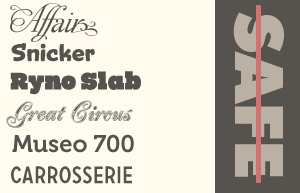You may have noticed, in your travels across the Web, that while web pages have a nearly infinite variability in their overall designs, the fonts on those pages are extremely limited. If you haven’t noticed, go ahead and surf to a few pages right now. Go ahead; I’ll wait.
Most web sites rely on a small collection of so-called “web safe” fonts — fonts that exist on a large majority of users’ computers and that will display as expected in their browsers.

Safe (but boring) Web Fonts
If you want to use a font that you have but visitors to your website might not, you have traditionally had two choices. You could fire up your graphics editing program of choice and create a graphic using the font. It’ll look pretty, but the downside of this is that, obviously, users can’t copy and paste these graphics as text, nor can search engines or text-to-voice readers for those with disabilities recognize your graphic as text, without additional effort on your part. Also, making a change to the graphic is not nearly as simple as making a change to a text block on your site. Your other option is to use the font anyway, and using the magic of CSS have a font stack that tells web browsers which alternate fonts can safely substitute for your chosen font. The downside of this is that if a user doesn’t have your font, the design that you’ve spent countless hours creating is now effectively broken.
(There is another option that has gained a lot of traction over the last couple of years: image replacement techniques such as Cufon and SIFR. But that’s a topic for another post.)

Unsafe (but beautiful) Web Fonts
Now there’s a third option available to web designers: Embeddable web fonts. The technology is actually, by web standards, pretty old, harkening back to the heady days of Netscape Navigator 4. Microsoft had its own font embedding solution at least as far back as 1997, but it was a bear to implement and only worked in Internet Explorer.
The problems inherent in web font embedding have been tackled by a recent handful of startups making a run at commercializing the web font space:
Many of the services host the fonts on their own servers, and serve them up to a specific domain for a fee. Some of the services allow you to host the fonts on your own server. There are arguments on both sides as to which approach is better. (Those who host fonts for you argue that their servers are more reliable than yours; those who allow you to host the fonts yourself argue that this gives you a measure of autonomy that the other companies can’t match.)
In the end, the result is the same: hundreds of lovely fonts can now be used on your website to excellent typographic effect, and with none of the downsides of any of the alternative options for using non-standard fonts on the web. (Except having to pay for them, of course.)
Typekit has a lovely gallery of web fonts in use, as does the excellent informational site webfonts.info. Go check them out and get typographically inspired.



The fonts issue can be a major problem.I used to be in constant searching for the best and fanciest font until I discovered Gustavo Sazes (www.abstrata.net) and the amazing works he did using Times New Roman almost exclusively.From then on I stuck on Georgia and I decided that safe fonts can be inspiring! 🙂
Let’s hope word spreads so we get more variety online. There were several interesting presentations at SXSW 2010 on web fonts. One of the best can be found at:
http://www.slideshare.net/SamanthaWarren/sxsw-2010.
@Nikos – TNR and Georgia can be used to beautiful effect for sure. And one could argue (and it has been argued) that giving designers more font choices will only open up the web to more bad typography and overworked designs. But I’m all for the freedom to fail and the dangers of too many font choices!
Good post Alec. I just mentioned your post in my blog post about Google’s new Font API which is basically a free version of TypeKit’s service (with about 18 open source fonts). They collaborated with TypeKit to provide this. You don’t even need to sign up for an account.
http://www.rustybrick.com/google-offers-css-font-api-for-designers.html
I imagine people who really like this will move on to TypeKit’s paid service which gives you a much greater selection of fonts using the same technology. And I was actually surprised at how cheap it is.
Thanks, Michael. The Google font previewer is a really nice touch!